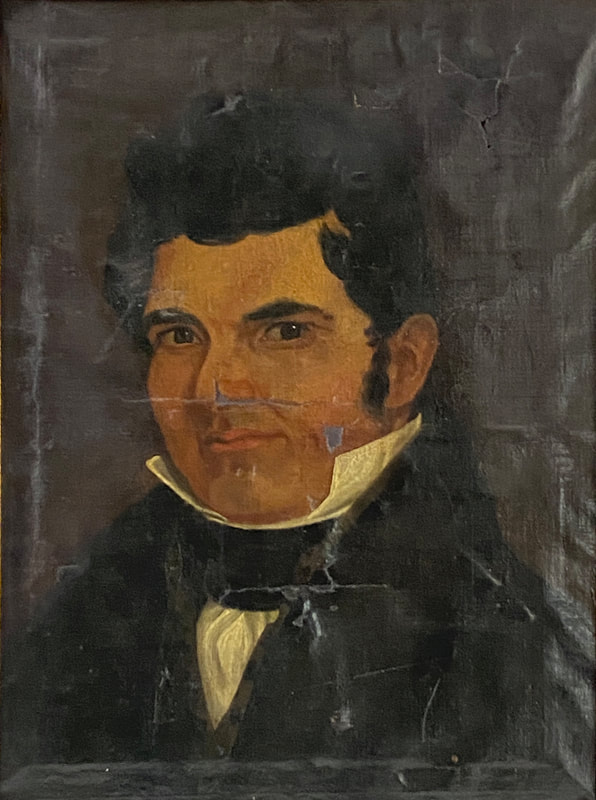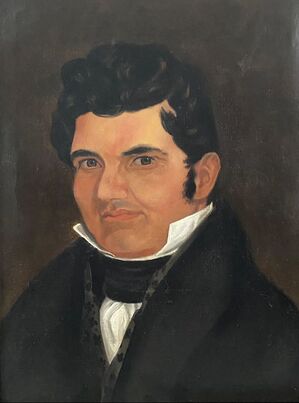|
Sylvia Outland, Art Curator
(featured in the July 2023 issue of the Medallion Newsletter) Earlier this year, the Ohio History Connection returned a portrait, to Harmon Museum, of James McDonald. As you can see from the before and after images, the portrait was in rough shape but has been restored by Old World Restorations of Cincinnati. It is not signed but we believe it can be attributed to Joseph Thoits Moore. Who was James Lawrence McDonald? Born in 1801 to a European father and a Choctaw mother in Mississippi, he was educated first in a nearby Quaker mission school. In 1813, at the age of twelve, his mother sent him to Baltimore to study under Phillip E. Thomas at the Quaker school there, who after a time, reached out to the Department of War, telling them of the possibility of using James to assist in the removal of Native Americans from tribal lands. Funded by the government, through the help of Secretary of War John C. Calhoon, McDonald continued his studies in Greek, Latin, philosophy, business, surveying and science. He was then pressured to pursue a degree in law, science or theology, but James wanted to return home to Choctaw territory to be close to his mother. However, in 1821 he began studying law under Ohio Supreme Court Justice John McLean, an early settler of Ridgeville, Warren County, Ohio and founder of The Western Star newspaper. James L. McDonald became the first Native American to be admitted to the Ohio bar in 1823. It is noted in the Western Star of July 12, 1823, “At the Supreme Court lately held at Dayton, Phineas Ross, Jesse Corwin, James L. McDonald and Thomas G Ward were severally admitted to practice a Counsellors, Solicitors and Attorneys in the Several Courts of Record in this state.” John C. Calhoon and Thomas McKenny tried to convince James to help assist in the removal of his native people. James refused and at that time returned to Choctaw territory becoming the first Choctaw lawyer and opponent of removal. In 1825 he was able to ensure the protection of mission schools, obtain high annuity payments and forgiveness of debts of the Choctaw. As an advocate of schooling, learning of social and cultural differences, and his experience of the harsh treatment he encountered during previous negotiations, James later came to believe that the only way for the Choctaw to survive was to agree to removal. In 1830 he signed the Treaty of Dancing Rabbit Creek. This treaty allowed those Choctaw who wished to, remain in Mississippi and become the first major non-European ethnic group to gain recognition as U. S. citizens. He stayed in Mississippi where he took his own life in 1831. Known for his Activism on behalf of the Choctaw Nation, McDonald’s work paved the way for future Native American leaders who were able to defend the rights of their territory using the American legal system. James Lawrence McDonald was an advocate and fighter for the rights and survival of his people and fought for them, their land and culture. His portrait is proudly displayed in the Harmon Museum. The portrait came to the Warren County Historical Society from Warren M. Miller of Hamilton, Ohio. He stated to Miriam Logan in a letter of February 1955: “Concerning the Indian painting which is in my possession, and the only one that I know of; it has never been photographed to my knowledge in my time…” “… It is very dark, and crudely patched in the region of the nose...” “You may tell Mrs. Phillips that I have seen to it in my will that it (the portrait) spends the remainder of its years in the Warren County Museum.”
0 Comments
Your comment will be posted after it is approved.
Leave a Reply. |
AuthorVarious staff and volunteer writers. Categories
All
Archives
May 2024
|
Email: info@wchsmuseum.org
Wchs Office/Harmon MuseumTues - Sat: 10am - 4pm
Year Round |
1795 BEEDLE cABINPhone for hours
Year Round |


 RSS Feed
RSS Feed





